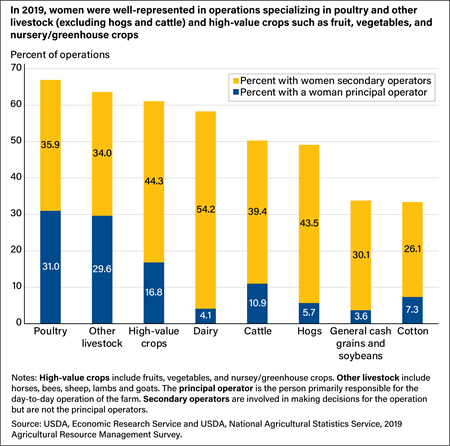Women Identified as Operators on 51 Percent of U.S. Farms in 2019

Women play an integral part in farming, either as a principal operator or as a decision-maker. In 2019, more than half (51 percent) of all farming operations in the United States had at least one woman operator, according to the 2019 Agricultural Resource Management Survey (ARMS). Women were the “principal operator,” meaning they are primarily responsible for the day-to-day operation of the farm, on 14 percent of operations. In 37 percent of operations, women were the “secondary operators,” involved in decisions for the operation but not the principal operators. Farms with principal female operators contributed more than 4 percent of the total value of production in 2019.
The share of principal operators who are women varied by commodity specializations. In 2019, the two largest shares of women principal operators were found on farms specializing in poultry (31 percent) and other livestock (30 percent). Operations specializing in dairy production had the largest share of operations with at least one woman secondary operator (54 percent). The smallest share (33 percent) of female operators, either principal or at least one secondary, was found on cotton farms. Among operations with at least one woman operator, 78 percent of the women were the principal operator’s spouse and worked on the farm.
The statistics cited in this article differ from those reported from the 2017 Census of Agriculture. Beginning in 2017, both the Census of Agriculture and ARMS began collecting demographic information for up to four operators per farm. However, unlike ARMS, the Census of Agriculture allows more than one operator to be identified as the principal operator and found that 29 percent of all principal operators were women.
America's Diverse Family Farms: 2020 Edition, by Christine Whitt, Jessica E. Todd, and James M. MacDonald, ERS, December 2020
U.S. Farm Employers Respond to Labor Market Changes With Higher Wages, Use of Visa Program, and More Women Workers, by Marcelo Castillo, USDA, Economic Research Service, October 2020
Socially Disadvantaged, Beginning, Limited Resource, and Female Farmers and Ranchers, by Katherine Lacy, USDA, Economic Research Service, January 2024
Farm Labor, by Marcelo Castillo and Skyler Simnitt, USDA, Economic Research Service, August 2023
Farm Household Well-being, by Katherine Lim, USDA, Economic Research Service, February 2024


